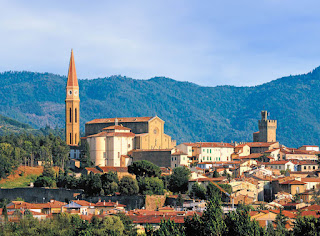Edward Hutton concluded "Siena and Southern Tuscany" in Arezzo, but in that chapter he did include a side trip by rail to Borgo San Sepolcro to see the famous Resurrection by Piero della Francesca.
But the most beautiful of all these treasures to which Arezzo holds the key is Borgo San Sepolcro in the Tiber Valley. … There are very few things more lovely in the world than the upper valley of the Arno, but one of them is, I think, the upper valley of the Tiber. It is a landscape more virile than Umbria—a landscape by Piero della Francesca, in fact, and in Borgo it is his work you find, for the little town is his birthplace.
That “Resurrection of Christ” in the Municipio is perhaps the most beautiful representation of the triumph of Christ in the world. …
The fresco of the resurrection comes upon us with a kind of surprise; we had not suspected Piero of so much thoughtfulness. It is as though he had listened to some voice, or seen a vision, or on some fortunate day had been led away the captive of Love, … In the cold light of the earliest morning, mere sunless dawn as yet, Christ has risen and is standing in His tomb. His experience is in His face, the dawn of knowledge, perhaps of the sorrows of humanity. It is as though for the first time He had really understood the power of evil, to which, after all, we are so unwillingly the slaves, the hopeless misery of that state of imperfect love. The noise of Hell has furrowed His face, and He has only just escaped into our quiet world. Beneath that terrible and beautiful figure… lie four soldiers, sleeping in the noiseless twilight. Behind the green trees on the right the first exquisite frail light of dawn is coming to comfort the world, and with the return of the Prince of Life the first day of spring has come; already the flowers have blossomed and the trees have budded behind Him as he came out of the sunrise, and when he shall turn at last into the garden, where Mary will find Him, those bare boughs, that naked hill-side, that brown and sterile earth will quicken, too, even as the hills that He has already crossed. All the passion of the encounter with Death and the dead is graven on His face, and though men sleep He can know no rest; He is up before them, and the whole long day is waiting for Him…. For Piero has expressed not only the old magical truths of Paganism and Christianity, the joy of the world at the coming of Spring, the triumph of the Prince of Life in a world pallid with the fear of Death, but the subtler and more terrible thoughts, too, of the age of thought that was just then dawning on the world. …
It was as such things as these in my heart that I made my way back to Arezzo, and, regretting them, took my leave of Southern Tuscany.
###
Edward Hutton: Siena and Southern Tuscany, New York, 1910. Pp. 316-318.








